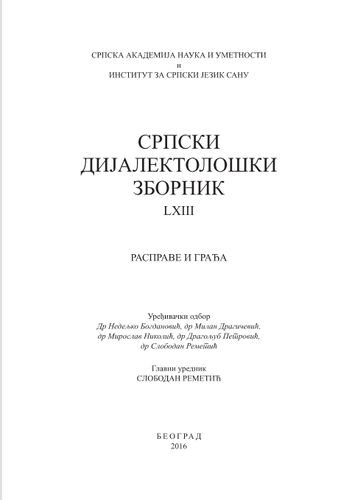Говор Прешева
Preševo Speech
Author(s): Tatjana G. TrajkovićSubject(s): Lexis, South Slavic Languages
Published by: Институт за српски језик Српске академије наука и уметности
Keywords: Serbian language; Preševo; dialectology; Prizren-Timok dialect area; South-Morava speech type
Summary/Abstract: Preševo municipality is located in the far south of Serbia, between the border with Macedonia in the south, administrative border with Kosovo and Metohija in the west and the municipality of Bujanovac and Trgovište in the northeast. It is comprised of the city settlement of Preševo and 34 villages. Serbs and Albanians make up the majority of the citizens in this area. The insufficient research done so far as well as the analyses of the speech of Preševo area was fragmented and, at least, incomplete. Besides, numerous sociological events began to change the image of the presence of Serbian language in this part of Serbia. The need for a more detailed examination of Serbian speech of Preševo area appeared and the result of that need is this paper. The paper is comprised of the following chapters: Introductory remarks, Phonetics, Morphology, From Syntax, Concluding remarks, Texts. The analysis of the material gathered on field is done by the already determined dialectology methods. According to its characteristics the speech of Preševo belongs to the most southern type of the South Morava speeches of Prizren-Timok dialect area. Basic characteristics of Preševo speech are: removal of the accent from the open ultima; accent paradigm; preservation of the semivowel; not as pronounced phenomenon of the facultative diphthong nature of the vowels of the middle row; the nasals of the back row in the verbs belonging to the III Belić type have reflex а; Ekavian replacement of jat; reflex lu for vocal l; the existence of affricate ѕ; consonants č, dž, ć and đ are of standard articulation; final l is in the working verbal adjective of male gender singular turned into -а; special iotation is executed; declination is pronouncedly analytic, which results in the doubling of personal pronouns with the use of prepositions; in nouns of neutral gender there are no forms with the expansion -n-, -m- or -s-; plural form of the nouns of neutral gender, apart from -а, are formed with the suffixes -iki, -ci and -inja; collective nouns ending in -је show the tendency towards the semantic congruence; nouns braća[brothers] and deca[children] in the process of congruence are equaled with the nouns of male gender in plural; some nouns pluralia tantum developed the singular-plural paradigm; the plural of personal nouns of 1st and 2nd person has the following forms: mi[we] and vi[you]; representation of belonging is usually analytic; Present tense of 1st person singular can have the suffix -m and -u; Present tense of 3rd person plural in the speech of Preševo ends in -v; aorist and imperfect aspect are in live use; there are cases of the generalized suffix -li in male and neutral gender plural of the working verbal adjective; there are also cases of generalization of -le in the working verbal adjective for all three genders of plural; Future I is formed as the construction će + Present for all three persons singular and plural; present verbal adverb ends with suffixes -eći and -е(ј)еći; iterative verbs are formed with the -uva- formant; using negative forms of verbs in the following construction: no + pronoun enclitic + verb. It was shown that the Preševo area is an area of numerous phonetic and morphological isoglosses which are represented on the maps in this paper. The research done on the speech of Preševo opens up the question of the situation in the near-by speeches (Bujanovac, Vranje) which would complete Ser-bian dialectological representation of this area.
Journal: Српски дијалектолошки зборник
- Issue Year: 63/2016
- Issue No: 1
- Page Range: 277-578
- Page Count: 302
- Language: Serbian

